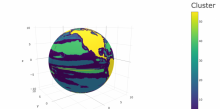Maike Sonnewald, a postdoc who has a background in physical oceanography and data science, uses computers to reveal connections and patterns in the ocean that would otherwise be beyond human capability. Recently, she applied a machine learning algorithm that sifted through vast amounts of data to identify patterns in the ocean that have similar physics, showing that there are five global dynamically consistent regions that make up the global ocean.
“It is amazing because it's so simple,” says Sonnewald. “It takes the really complicated world ocean and distills it down to a few important patterns. We use these to infer what's going on and to highlight areas that are more complicated.”
Sonnewald and co-authors Carl Wunsch, EAPS professor emeritus of physical oceanography and PAOC member, and Patrick Heimbach, an EAPS research affiliate and former senior research scientist, now at the University of Texas at Austin, published their findings in a special issue on “Geoscience Papers of the Future” in Earth and Space Science.
Link to article:



